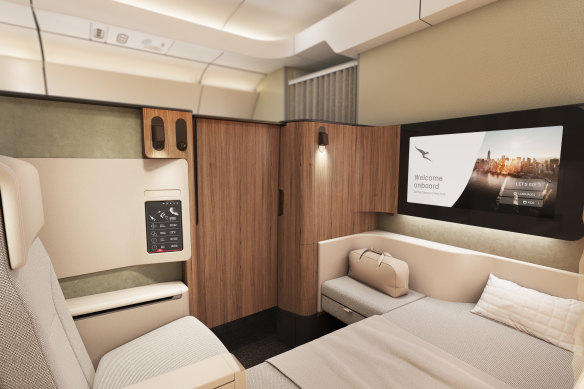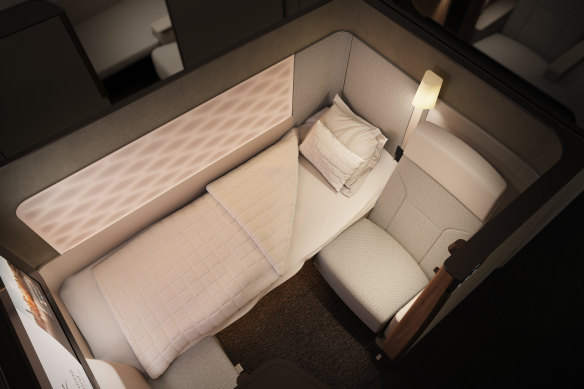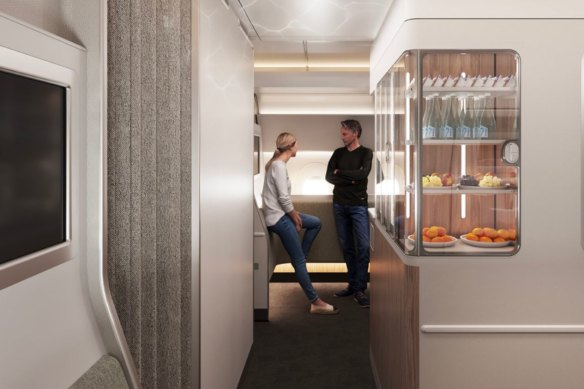Like a private jet: Sneak peek inside Qantas’ new first class
By John Arlidge
A decade after airlines rushed to ditch first-class cabins in favour of new upgraded business-class suites, first is back in style.
British Airways will soon unveil a new first-class suite on its Airbus A380 superjumbos and is creating new teams of dedicated first-class cabin crew. Emirates is spiffing up the first-class cabins on its A380s, which offer showers. The seats are better upholstered and there are new pyjamas and slippers.

Qantas has unveiled one of the most elegantly understated first-class cabins in the world.
Etihad, the Abu Dhabi flag carrier, has resumed flying its A380, which offers the Residence, a 12-square-meter-room micro apartment with a lounge area, bathroom with shower, and double bed in the nose. Yours for $10,700 for one passenger, or $17,600 for two, from London to Abu Dhabi (the airline no longer flies the A380 to Australia). Singapore Airlines offers double beds in its Suites class on its A380s.
But one carrier outshines them all. Qantas. The Australian flag carrier has unveiled the most exclusive, stylish and hi-tech airline cabin anywhere outside a private jet. At the Airbus factory in Toulouse, we got a sneak peek at the cabin that will be installed on Qantas’s ultra-long-haul Airbus A350 jets, which will soon start flying 21 hours non-stop from London and New York to Sydney and Melbourne.
There are six large enclosed suites, arranged in a 1-1-1 formation across the front of two rows of seats in the four-class jet. Each comes with a 0.6 metre-wide reclining seat, separate two-metre-long bed, wardrobe, 32-inch (81-centimetre) TV, and dining table that can comfortably seat three people. The bed has a headboard that can be angled forwards, so you can sit up in bed to read, watch a film or live sports streamed on the ultra-fast Wi-Fi, or simply look out of the window. There are five lights in each suite which you can use to create the exact brightness and tone you want.

The new Qantas first-class cabins will come with a 0.6m-wide reclining seat and separate 2m-long bed.
The colour palette is light with eggshell seat fabrics and sage green trim to create what designer David Caon calls “an authentically Australian aesthetic. In your beach house you don’t have dark and moody. You have lighter, fresher colours.” Wrapping around the walls and door is what looks like European oak, with a textured grain, but is, in fact, a synthetic veneer. “Real wood gets bashed about a lot and is hard to refinish and maintain,” Caon explains.
Each of the six stowage compartments in the suite is integrated into the surfaces and closes flush. “I want everything to fold away completely to create visual calm,” says Caon.
The touchscreen controls for the seat position and lighting are discreetly mounted in a panel in the wall, and there’s wireless charging built into the surface storage areas. There are two bathrooms for the passengers in the six suites.
The stowage compartments in the suites means there are no overhead bins at all in the first-class cabin. This has helped Qantas introduce the most sophisticated and stylish cabin lighting in any commercial airliner, which it will use to help passengers in all classes to adjust to their destination time zone – crucial on the 21-hour non-stop flights to Oz.
“Awake” is blue-enriched lighting to help you to stay up even though you might want to doze off. “Sunset” moves through the colours of dusk into a night sky over several minutes. It ends in “moonlight” with a slow-moving cloud effect to relax customers and prepare them for sleep. I tried it out on a mock-up of the jet and it instantly made me feel sleepy even in the middle of the day. “Sunrise” rolls from the front of the cabin to the rear over several minutes, mimicking a real dawn on the horizon with blue on the ceiling and warm reds at the sides.

All travellers will have access to the Wellness Zone.
Each cabin will also have “Dining day” and “Dining night” settings. There are “Welcome” and “Farewell” scenes for boarding and disembarking, as well as tailored colours for taxi, take-off and landing. The first-class cabin welcome lighting is a mix of blue, warm white, apricot and pink. There is even a “Mardi Gras” setting which makes the Airbus a party bus.
The snazziest lighting of all is in the eight-square-metre Wellbeing Zone, between the economy and premium economy cabins, which all passengers can use to stretch, socialise, eat healthy snacks and enjoy (non-alcoholic) drinks. Caon, Qantas and Airbus have used special lenses in front of the galley-mounted LEDs to make the light ripple over the ceiling and side walls, like sunlight refracted off the surface of a swimming pool. “It creates a sense of calm and space and is quintessentially Australian,” says Caon.
The lighting is the result of more than 150 hours of testing in Airbus’s Customer Definition Centre in Hamburg carried out by Qantas, Caon and the University of Sydney’s Charles Perkins Centre, which researches how long-haul travel affects passengers and how best to combat jet lag.
“Aircraft lighting doesn’t cross the mind of most travellers but light plays an important part in controlling our body clocks,” says Caon. “By manipulating the timing, strength and wavelengths of light during a flight, it’s possible to ‘trick’ passengers into staying awake and going to sleep at times that will help them to hit the ground running when they land.”
The only enviable problem with Qantas first class is how much to charge for a non-stop return from London to Sydney and Melbourne. The airline’s new boss, Vanessa Hudson, is an accountant, so expect sticker shock. My money’s on $30,000.
The Telegraph, London
Sign up for the Traveller newsletter
The latest travel news, tips and inspiration delivered to your inbox. Sign up now.